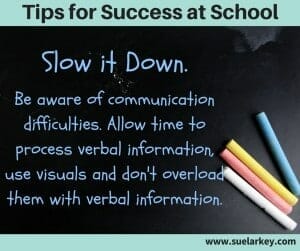-
Understand their difference (strengths and challenges), accept their different way of thinking, learning, socialising, etc .(Great reference to understanding ASD is Dr Tony Attwood’s books).
- Break it down. Break tasks down into smaller parts and give them each step sequentially. If possible, give them a checklist to mark off as they do each step. Do NOT expect the children to multitask! Allow them extra time to get it done, but let them finish! It is important to finish one task before going to another.
- Slow it down. Be aware of communication difficulties. Allow time to process verbal information, use visuals, and don’t overload them with verbal information.
- Use their special interests to motivate and engage – their strengths are motivated by their interest.
- Show them what is expected and what is happening, then they have less need to fight for control (i.e. schedules, routines, timers).
- Be careful how you use words, their literalness can mean they misunderstand you. Avoid words like ‘could’, ‘would’, ‘can’ as they perceive them as a choice. e.g. “Can you start work” can be seen as a choice.
- Use visuals to support learning: schedules, photos, pictures, Pics for PECS, timetables, highlight key information, mind maps, etc.
- Prepare by previewing. If possible ‘preview’ the learning ahead of time, to give a mental framework of what is being presented or what is next.
- Check in regularly – don’t wait for the student to ask for help – check in (learning, social and education).
- Computers and iPads are enabling for so many people with ASD, they can help build connections and confidence. (See tips for iPad’s on Tips Page).
- They find it hard to see things from other people’s perspective. This is known as ‘theory of mind’. They might also find it hard to understand and predict other people’s behaviour, and to understand how their behaviour affects others.
- They often find it hard to recognise facial expressions and the emotions behind them. They may miss facial cues from adults about behaviour, or social cues from peers.
To Download Tip in easy to read format (plus bonus of 8 Strategies for Working with Families) Click the link below
Tips 12 Tips for Success (& bonus 8 Strategies for Working with Families)
Bonus of Another 3 Tip Sheets for Teaching (many many more strategies on the Tip Sheet Page)
Preparing the Classroom for Students with ASD
Tip_Sheet_-_Creating_Communication_Enriched_Environments




 Sorry we no longer ship items outside Australia. Please consider the digital versions of Sue’s Books –
Sorry we no longer ship items outside Australia. Please consider the digital versions of Sue’s Books – 